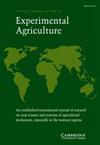可可幼苗的生长和开花可通过施用有机和硝酸盐肥料来促进
IF 1.9
4区 农林科学
Q1 Agricultural and Biological Sciences
引用次数: 0
摘要
印度尼西亚苏拉威西岛(Sulawesi)的可可(Theobroma可可)农民通常使用补贴的氨基水稻肥料,这种肥料与不良的农业实践相结合,导致土壤酸化、有机质流失、铝毒性和土壤肥力降低。因此,这些土壤只能勉强适合重新种植可可以提高产量。通过田间试验,对不同土壤改良剂在这些土壤缺陷上成功再植可可进行了试验。在一项随机区组设计的试验中,6个月大的幼苗,顶部嫁接当地的MCC02无性植株,种植在浅色遮荫下,3个月后,每季度用两种矿物肥料处理:一种由硝酸钾(硝酸钙和硼的混合物)、白云石、磷灰石和氯化钾组成的定制肥料,或农民使用的氮磷钾/尿素混合物,每种肥料都有或没有“微量营养素”岩盐、有机肥和有益微生物或它们的培养基、几丁质和氨基酸的混合物(共20种处理)。在4年期间,定制肥料处理的茎粗增长率和开花分数的边际平均率高于氮磷钾/尿素处理。平均增长率在第一年最高,并通过施用有机肥来提高。速效磷与生长呈极显著相关(r = 0.22, p < 0.05),但氮磷钾/尿素地块速效磷浓度较高,平均生长速率较低。在定制处理和氮磷钾/尿素处理中,有机肥和微生物的联合施用提高了速效磷和生长率。相比之下,未经这些改良的氮磷钾/尿素处理地块的生长速度非常低。无论是否添加有机肥或接种微生物,定制配方都更有效。微量营养素的供应促进了开花。施用氮磷钾/尿素的树木的生长速率也受到微量元素的促进。冲叶的产生有规律的周期,不受养分修正的影响。3年后,定制化有机肥料的施用提高了土壤pH值和可交换钙和镁浓度,尽管它们仍低于可可生产的推荐水平。这些处理对土壤C含量影响不大(约1.3%),土壤C含量也不足。氮磷钾/尿素处理土壤的交换性铝和总锌含量较高。试验结果提供了证据,表明有机肥料与定制的硝酸盐配方结合使用可以改善可可的生长、生长和土壤性质,应该推荐作为农民传统使用的氮磷钾/尿素肥料的替代品。本文章由计算机程序翻译,如有差异,请以英文原文为准。
Growth and flowering of young cocoa plants is promoted by organic and nitrate-based fertiliser amendments
Summary Cocoa (Theobroma cacao) farmers in Sulawesi, Indonesia typically use subsidised, ammonium-based rice fertilisers that in combination with poor agricultural practices have resulted in soil acidification, loss of organic matter, aluminium toxicity and lower soil fertility. As a result, these soils are only marginally appropriate for replanting cocoa to boost production. A field experiment was performed to test alternative soil amendments for successful replanting of cocoa on these deficient soils. In a trial with a randomised block design, 6-month old seedlings, top-grafted with the local MCC02 clone, were planted under light Gliricidia sepium shade and after 3 months treated quarterly with two options of mineral fertilisers: either a customised fertiliser, consisting of Nitrabor (a combination of calcium nitrate and boron), dolomite, rock phosphate and KCl or a NPK/urea mix used by farmers, each supplied with or without ‘micronutrient’ rock salt, organic fertiliser and beneficial microorganisms or their culture medium, a mixture of chitin and amino acids (a total of 20 treatments). Over a 4-year period, the marginal mean rates of stem diameter increment and flowering score were higher in customised fertiliser than NPK/urea treatments. The average growth rate was highest in the first year and was increased by supplying organic fertiliser. A significant correlation (r = 0.22, p < 0.05) occurred between growth and available P, but concentrations of available P were higher in the NPK/urea plots, which also had lower mean growth rates. Combined supply of organic fertiliser and microbes increased available P, as well as growth rates, in both the customised and NPK/urea treatments. In contrast, NPK/urea-treated plots without these amendments demonstrated very low growth rates. The customised formulation was more effective with or without added organic fertiliser or inoculated microbes. Micronutrient supply stimulated flowering. Growth rates in trees supplied with NPK/urea were also promoted by micronutrients. Leaf flush production occurred in regular cycles and was unaffected by the nutrient amendments. After 3 years, the customised and organic fertiliser application increased soil pH and exchangeable Ca and Mg concentrations, although they remained below recommended levels for cocoa production. These treatments had little impact on soil C content (about 1.3%) which was also deficient. Exchangeable Al and total Zn concentrations were higher in soils amended with NPK/urea. The results of the trial provide evidence that utilisation of organic fertiliser in combination with customised nitrate-based formulations improves cocoa establishment, growth and soil properties and should be recommended as a replacement for the NPK/urea fertilisers traditionally used by farmers.
求助全文
通过发布文献求助,成功后即可免费获取论文全文。
去求助
来源期刊

Experimental Agriculture
农林科学-农艺学
CiteScore
2.50
自引率
6.20%
发文量
29
审稿时长
24 months
期刊介绍:
With a focus on the tropical and sub-tropical regions of the world, Experimental Agriculture publishes the results of original research on field, plantation and herbage crops grown for food or feed, or for industrial purposes, and on farming systems, including livestock and people. It reports experimental work designed to explain how crops respond to the environment in biological and physical terms, and on the social and economic issues that may influence the uptake of the results of research by policy makers and farmers, including the role of institutions and partnerships in delivering impact. The journal also publishes accounts and critical discussions of new quantitative and qualitative methods in agricultural and ecosystems research, and of contemporary issues arising in countries where agricultural production needs to develop rapidly. There is a regular book review section and occasional, often invited, reviews of research.
 求助内容:
求助内容: 应助结果提醒方式:
应助结果提醒方式:


